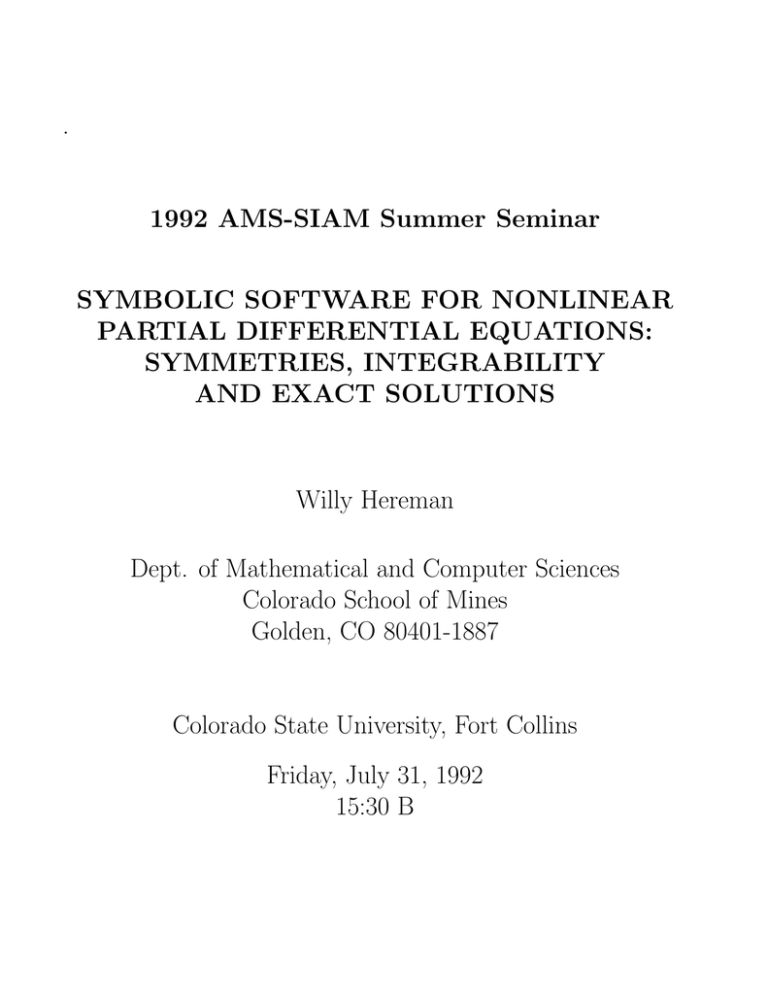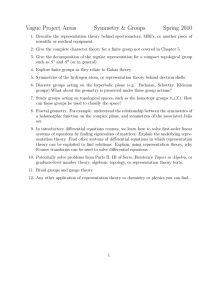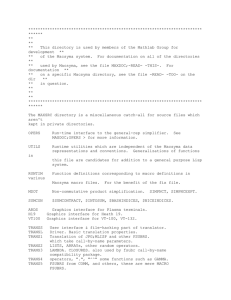. 1992 AMS-SIAM Summer Seminar SYMBOLIC SOFTWARE FOR NONLINEAR PARTIAL DIFFERENTIAL EQUATIONS:
advertisement

. 1992 AMS-SIAM Summer Seminar SYMBOLIC SOFTWARE FOR NONLINEAR PARTIAL DIFFERENTIAL EQUATIONS: SYMMETRIES, INTEGRABILITY AND EXACT SOLUTIONS Willy Hereman Dept. of Mathematical and Computer Sciences Colorado School of Mines Golden, CO 80401-1887 Colorado State University, Fort Collins Friday, July 31, 1992 15:30 B Calculation of Lie-point and Generalized Symmetries • SPDE by Schwarz (Reduce, Scratchpad, 1986) • Symmetries via exterior differential forms by Kersten and Gragert (Reduce, 1987) • Lie-Bäcklund symmetries by Fedorova, Kornyak and Fushchich (Reduce, 1987) • Crackstar by Wolf (Formac, 1987) • CRACK by Wolf (Reduce, 1990) • Lie-point symmetries by Schwarzmeier and Rosenau (Macsyma, 1988) • Special symmetries by Mikhailov (Pascal, 1988) • LIE by Head (muMath, 1990) • Lie program by Nucci (Reduce, 1990) • PDELIE by Vafeades (Macsyma, 1990) • DEliA by Bocharov (Pascal, 1990) • SYM DE by Steinberg (Macsyma, 1990) • SYMCAL by Reid (Macsyma, 1990) • SYMMGRP.MAX by Champagne, Hereman and Winternitz (Macsyma, 1990) • Lie symmetries by Herod, Berube, Wilcox (Mathematica, in development 1992) Example 1 - Macsyma Lie-point Symmetries • System of m differential equations of order k ∆i(x, u(k)) = 0, i = 1, 2, ..., m with p independent and q dependent variables x = (x1, x2, ..., xp) ∈ IRp u = (u1, u2, ..., uq ) ∈ IRq • The group transformations have the form x̃ = Λgroup (x, u), ũ = Ωgroup (x, u) where the functions Λgroup and Ωgroup are to be determined • Look for the Lie algebra L realized by the vector field q ∂ ∂ X + ϕl (x, u) l α= η (x, u) i=1 ∂xi l=1 ∂u p X i Procedure for finding the coefficients • Construct the k th prolongation pr(k)α of the vector field α • Apply it to the system of equations • Request that the resulting expression vanishes on the solution set of the given system pr(k)α∆i |∆j =0 i, j = 1, ..., m • This results in a system of linear homogeneous PDEs for η i and ϕl , with independent variables x and u (determining equations) • Procedure thus consists of two major steps: deriving the determining equations solving the determining equations Procedure for Computing the Determining Equations • Use multi-index notation J = (j1, j2, ..., jp) ∈ INp, to denote partial derivatives of ul |J| l ∂ u l uJ ≡ , ∂x1j1 ∂x2j2 ...∂xpjp where |J| = j1 + j2 + ... + jp • u(k) denotes a vector whose components are all the partial derivatives of order 0 up to k of all the ul • Steps: (1) Construct the k th prolongation of the vector field (k) pr α = α + q X X l=1 J ψlJ (x, u(k)) ∂ , ∂ulJ 1 ≤ |J| ≤ k The coefficients ψlJ of the first prolongation are: ψlJi = Diϕl (x, u) − p X j=1 ulJj Diη j (x, u), where Ji is a p−tuple with 1 on the ith position and zeros elsewhere Di is the total derivative operator q X ∂ ∂ X + ulJ+Ji l , 0 ≤ |J| ≤ k Di = ∂xi l=1 J ∂uJ Higher order prolongations are defined recursively: ψlJ+Ji = DiψlJ − p X j=1 ulJ+Jj Diη j (x, u), |J| ≥ 1 (2) Apply the prolonged operator pr(k)α to each equation ∆i(x, u(k)) = 0 Require that pr(k)α vanishes on the solution set of the system pr(k)α ∆i |∆j =0 = 0 i, j = 1, ..., m (3) Choose m components of the vector u(k), say v 1, ..., v m, such that: (a) Each v i is equal to a derivative of a ul (l = 1, ..., q) with respect to at least one variable xi (i = 1, ..., p). (b) None of the v i is the derivative of another one in the set. (c) The system can be solved algebraically for the v i in terms of the remaining components of u(k), which we de- noted by w: v i = S i(x, w), i = 1, ..., m. (d) The derivatives of v i, vJi = DJ S i(x, w), where DJ ≡ D1j1 D2j2 ...Dpjp , can all be expressed in terms of the components of w and their derivatives, without ever reintroducing the v i or their derivatives. For instance, for a system of evolution equations uit(x1, ..., xp−1, t) = F i(x1, ..., xp−1, t, u(k)), i = 1, ..., m, where u(k) involves derivatives with respect to the variables xi but not t, choose v i = uit. (4) Eliminate all v i and their derivatives from the expression prolonged vector field, so that all the remaining variables are independent (5) Obtain the determining equations for η i(x, u) and ϕl (x, u) by equating to zero the coefficients of the remaining independent derivatives ulJ . Example 2 – Macsyma Painlevé Integrability Test Integrability of a PDE requires that the only movable singularities in its solution are poles Definition: A simple equation or system has the Painlevé Property if its solution in the complex plane has no worse singularities than movable poles Aim: Verify if the PDE satisfies the necessary criteria to have the Painlevé Property The solution f expressed as a Laurent series, f =g ∞ α X k=0 should only have movable poles. uk g k u0(t, x) 6= 0, α is a negative integer uk (t, x) are analytic functions in a neighborhood of the singular, non-characteristic manifold g(t, x) = 0, with gx(t, x) 6= 0 Steps of the Painlevé Test • Step 1: 1. Substitute the leading order term, f ∝ u0 g α into the given equation 2. Determine the integer α < 0 by balancing the most singular terms in g 3. Calculate u0 • Step 2: 1. Substitute the generic terms f ∝ u0 g α + ur g α+r into the equation, retaining its most singular terms 2. Require that ur is arbitrary 3. Calculate the corresponding values of r > 0, called resonances • Step 3: 1. Substitute the truncated expansion f =g R α X k=0 uk g k , (4) where R represents the largest resonance, into the complete equation 2. Determine uk unambiguously at the non-resonance levels 3. Check whether or not the compatibility condition is satisfied at resonance levels • An equation or system has the Painlevé Property and is conjectured to be integrable if: 1. Step 1 thru 3 can be carried out consistently with α < 0 and with positive resonances 2. The compatibility conditions are identically satisfied for all resonances • For an equation to be integrable it is necessary but not sufficient that it passes the Painlevé test • The above algorithm does not detect the existence of essential singularities Demo Painlevé Test Korteweg-de Vries equation ut + 6uux + u3x = 0 Example 4 – Macsyma Positioning of Equipment A Trilateration Problem Calculate the unknown 3D-position of a point, given the distances from that point to a set of fixed points x and y are the horizontal coordinates z is the altitude of the unknown point Questions: • Is there a mathematical solution? • What is the smallest number of beacons needed? • Can the position of the bulldozer be determined “fairly accurately” if the distances are inaccurate? • What are the optimal positions of the beacons? • What is the ‘best’ optimal algorithm for the solution? • Can the algorithm be translated into a fast C-program? • What are the possible applications of the problem? A Mathematical Solution Linearization (xi, yi, zi) (i = 1, 2, ..., n) are the known coordinates of the n beacons (x, y, z) are the unknown coordinates of the bulldozer ri are measured approximate slope distances from bulldozer to beacons Constraints (x − xi)2 + (y − yi)2 + (z − zi)2 = ri2 Use the j th constraint as a linearizing tool Add and subtract xj , yj and zj (x − xj + xj − xi)2 + (y − yj + yj − yi)2 + (z − zj + zj − zi)2 = ri2 Expand and regroup terms (x − xj )(xi − xj ) + (y − yj )(yi − yj ) + (z − zj )(zi − zj ) 1 = [(x − xj )2 + (y − yj )2 + (z − zj )2 2 −ri2 + (xi − xj )2 + (yi − yj )2 + (zi − zj )2] = 1 2 [rj − ri2 + d2ij ] 2 where s dij = (xi − xj )2 + (yi − yj )2 + (zi − zj )2 is the distance between beacons i and j Select j = 1, thus for i = 2, 3, ..., n linear system of (n − 1) eqs. in 3 unknowns: (x − x1)(x2 − x1) + (y − y1)(y2 − y1) + (z − z1)(z2 − z1) 1 = [r12 − r22 + d221] = b21 2 (x − x1)(x3 − x1) + (y − y1)(y3 − y1) + (z − z1)(z3 − z1) 1 = [r12 − r32 + d231] = b31 2 .. (x − x1)(xn − x1) + (y − y1)(yn − y1) + (z − z1)(zn − z1) 1 = [r12 − rn2 + d2n1] = bn1 2 In matrix form A~x = ~b, with y2 − y1 z2 − z1 x2 − x1 x − x y − y z − z 3 1 3 1 3 1 A = . . . . . . . xn − x1 yn − y1 zn − z1 x − x1 ~x = y − y1 , z − z1 b21 b ~b = 31 .. bn1 The Least Squares Method The distances ri are only approximate Determine ~x such that A~x ≈ ~b Minimize the sum of the squares of the residuals T ~ S = ~r ~r = (b − A~x) (~b − A~x) T Solve the normal equation AT A~x = AT~b If AT A is non-singular then ~x = (AT A)−1AT~b Determine the effect of adding errors to the radii Demo with the actual data from the coal mine


